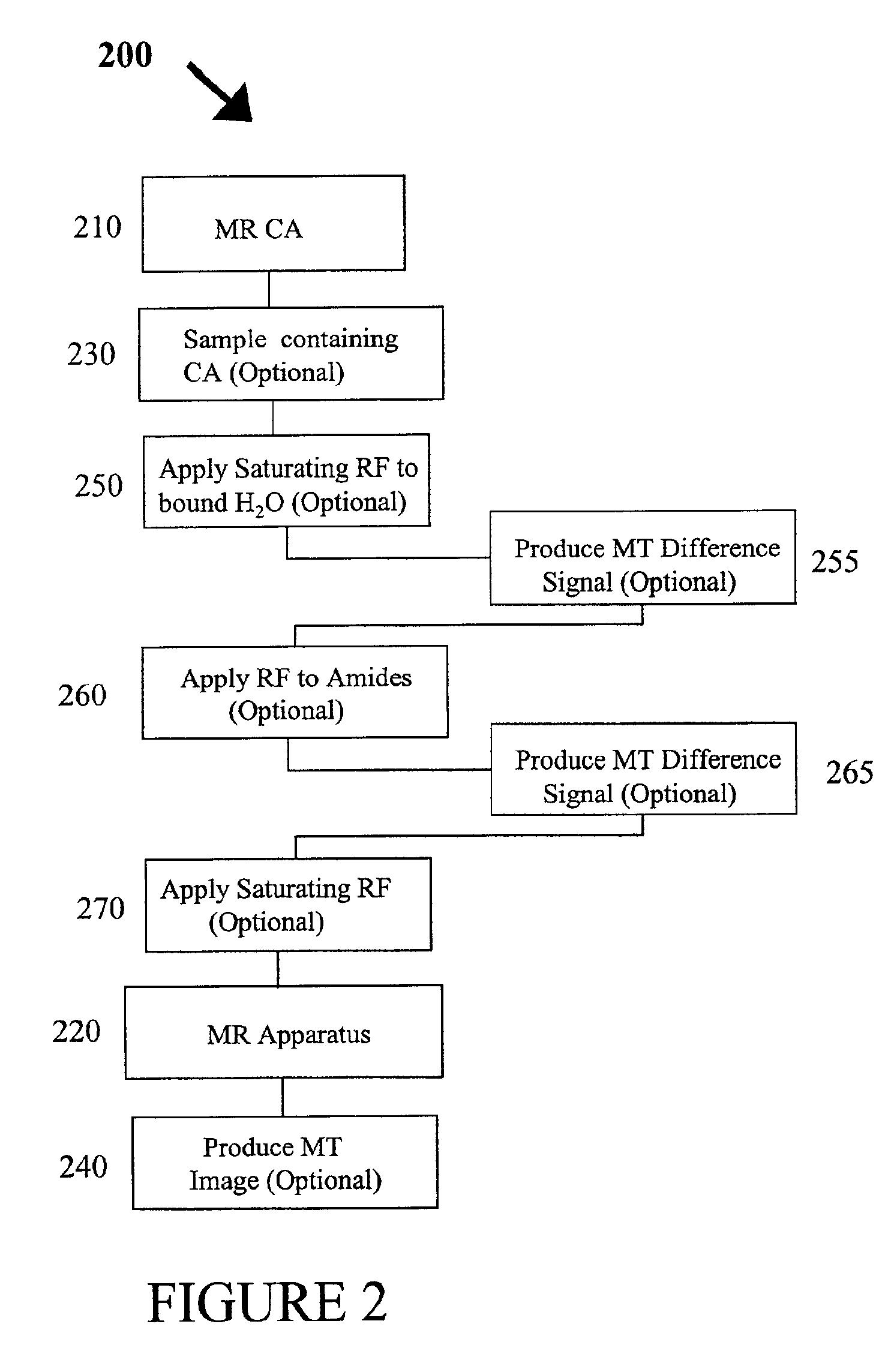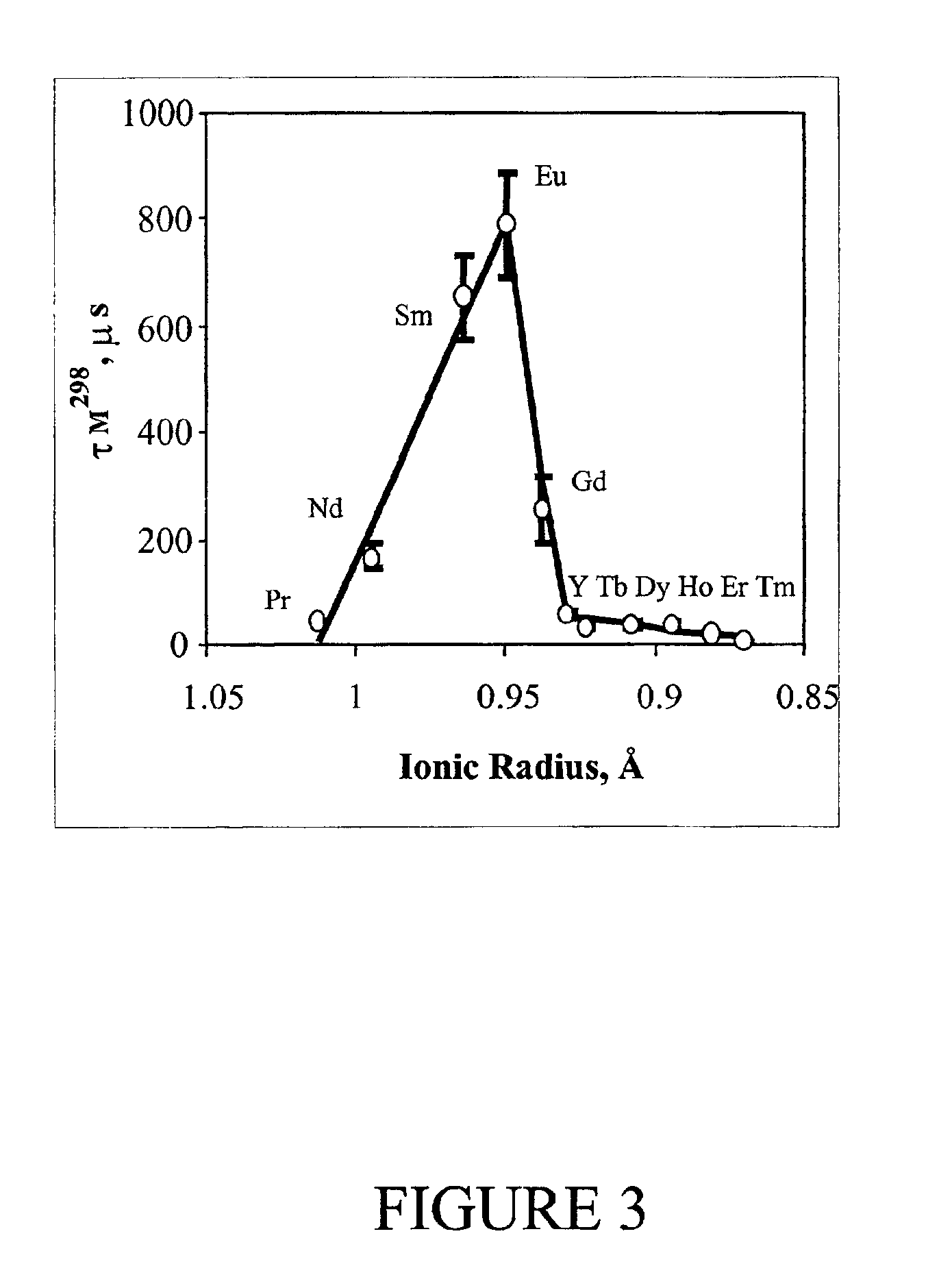Paramagnetic metal ion-based macrocyclic magnetization transfer contrast agents and method of use
a macrocyclic magnetization and contrast agent technology, applied in the field of contrast agents, can solve the problems of slow water exchange rate, limited use of living subjects of cas, and difficulty in avoiding off-resonance saturation of bulk water or tightly protein-bound water in tissue samples
- Summary
- Abstract
- Description
- Claims
- Application Information
AI Technical Summary
Problems solved by technology
Method used
Image
Examples
experiment 1
A first experiment, examined the life times at 298° K; τM298, of water molecules bound to various lanthanide-macrocylic complexes of the present invention, and having the general formula, Ln(1)3+, where the four pendent arms R, R′, R″ and R′″ are all ethyl-acetamidoacetate (i.e., LnDOTA-4AmCE3+), as depicted below:
As illustrated in FIG. 3, τM298 is strongly dependent on the radius of the central lanthanide ion. The plot shows the τM298 measured for a series of Ln(1)3+ complexes in acetonitrile plus 2-4% water versus the Ln3+ ionic radii. Individual τM298 values were obtained by fitting the temperature dependent 17O NMR bound water line widths according to standard exchange theory. In a separate series of experiments, it was found that τM298 was about 2-fold shorter when pure water was the solvent. Because the bulk water 17O resonance of Yb(1) solution was relatively narrow at all temperatures, no attempt was made to determine τM298 for this complex based on the 17O NMR line width d...
experiment 2
In a second experiment, MT profiles, also known as Z-profiles or CEST profiles, were obtained for lanthanide-macrocylic complexes of the general formula Ln(1)3+. FIGS. 4-7 show representative spectra in the absence of saturation (bulk water peak at 0 ppm truncated to make the bound water peaks more visible) and MT profiles for Eu(1)3+, Pr(1)3+, Nd(1)3+ and Yb(1)3+ complexes, respectively, all measured at 4.7 T. All experiments were conducted using aqueous 62.5 mM Ln(1)3+ adjusted to neutral pH and about 22° C., using an saturation duration time of 1 s, RF power of 16 db, and a 2.5 cm surface coil. FIGS. 4, 5 and 6 illustrate that Eu(1)3+, Pr(1)3+ and Nd(1)3+ all display strong MT properties when a saturating RF pulse is directed at their bound water positions of +50, −45 and −36 ppm, respectively (with bulk water at 0 ppm). Among these three complexes, Eu(1)3+, shown in FIG. 4, had the greatest effect when the saturating pulse was centered at about 50 ppm (arrow): about a 60% decrea...
experiment 3
A third series of experiments was performed to examine the ability of lanthanide-macrocylic complexes of the general formula Ln(1)3+ to enhance MRI contrast by MT. FIGS. 8 and 9 demonstrate image contrast obtained using aqueous solutions of 62.5 mM Eu(1)3+ and Nd(1)3+, respectively. The inner vial contains 62.5 mM Eu(1)3+ or Nd(1)3+ at neutral pH, while the outer vial is pure water. T1-weighted spin-echo images (TR / TE=500 / 18 ms, 256×256 data matrix) were obtained at about 22° C. and a field strength of 4.7 T. MT was achieved by applying RE irradiation for 1 s, with a power of 16 db by using a 2.5 cm surface coil. FIG. 8 shows images obtained with no saturation (left, nosat), saturation at +9800 Hz (middle, Satp) at the resonance frequency of Eu3+-bound water, saturation at −9800 Hz (right, satn), and the corresponding difference images. FIG. 9 shows analogous images for a phantom with no saturation (left, nosat), saturation at −6400 Hz (middle, Satp) the resonance frequency of Nd3+-...
PUM
| Property | Measurement | Unit |
|---|---|---|
| temperature | aaaaa | aaaaa |
| chemical shifts | aaaaa | aaaaa |
| chemical exchange saturation transfer | aaaaa | aaaaa |
Abstract
Description
Claims
Application Information
 Login to View More
Login to View More - R&D
- Intellectual Property
- Life Sciences
- Materials
- Tech Scout
- Unparalleled Data Quality
- Higher Quality Content
- 60% Fewer Hallucinations
Browse by: Latest US Patents, China's latest patents, Technical Efficacy Thesaurus, Application Domain, Technology Topic, Popular Technical Reports.
© 2025 PatSnap. All rights reserved.Legal|Privacy policy|Modern Slavery Act Transparency Statement|Sitemap|About US| Contact US: help@patsnap.com



